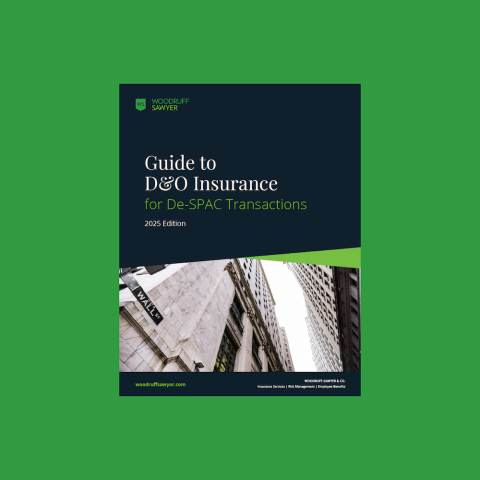Guide
Guide to D&O Insurance for De-SPAC Transactions, 2025 Edition [Report]
The SPAC market is making a comeback—which certainly implies that we may see renewed interest by some private companies in going public by taking the de-SPAC route.
Even with the new wave of better-governed SPACs, there is still real legal exposure when it comes to the de-SPAC process. This is where Woodruff Sawyer’s 2025 Guide to D&O Insurance for De-SPAC Transactions comes in.
Whether you’re a SPAC sponsor, target company leader, or board member, the Guide provides a step-by-step roadmap for securing comprehensive D&O coverage, reducing risk, and staying ahead in this complex environment.
The SPAC Landscape: Signs of Revival
Is the SPAC market experiencing a revival? Signs point to yes.
As we pointed out in our 2024 SPAC year-end analysis, in the second half of 2024, 57 SPAC IPOs raised a total of $9.6 billion. Additionally, 73 business combinations valued at nearly $38 billion were finalized, with 61 more announced and pending.
As we head into this new year, we continue to see the next generation of SPACs emerging—"SPAC 4.0." These companies put more emphasis on due diligence, better governance practices, and risk mitigation strategies.
Even with a more strategic approach, however, companies that go public through a de-SPAC business combination are still a target for litigation.
Our data show that SPAC-related securities class actions usually happen within the first three years after the de-SPAC business combination; 96% of SPAC-related M&A suits in 2024 named SPAC sponsors as defendants; and fiduciary duty suits in Delaware have also been on the rise. This is a driving force behind SPACs making the Cayman Islands their home.
Add to this the fact that 2025 has seen two of the largest SPAC-related settlements to date—$80 million for Grab Holdings Limited and $126.3 million for Alta Mesa Resources—and it’s unsurprising that SPAC sponsors and directors are increasingly focused on risk mitigation strategies.
Unfortunately, it’s not just these two extra-large settlement cases that are troubling when it comes to the duration of litigation and settlement amounts.
Over the past five years, SPACs have faced ongoing legal challenges with substantial settlements. According to Woodruff Sawyer’s Databox™:
- Fifty percent (50%) of SPAC-related securities class actions in federal court remain open, 25% were dismissed/withdrawn, and 25% settled, with total settlements reaching $528 million and the median settlement being $8.8 million.
- Fifty-eight percent (58%) of SPAC-related M&A lawsuits in Delaware Chancery Court remain open, 12% were dismissed/withdrawn, and 30% settled, with total settlements reaching $225 million with a median of $11.5 million.
That said, more companies that want to go public may choose this route in 2025 and beyond, particularly since the new presidential administration has made capital markets-friendly appointments that could help revive the SPAC space.
Why D&O Insurance Is Critical in 2025
Litigation surrounding de-SPAC transactions remains a serious risk and underscores the role D&O insurance can play when it comes to protecting directors and officers in costly lawsuits.
Having the right broker who understands the nuances of coverage for de-SPAC transactions can make the difference between a well-protected leadership team and one left exposed to significant risk.
Key Takeaways from the 2025 Guide
Woodruff Sawyer’s Guide to D&O Insurance for De-SPAC Transactions, 2025 Edition, outlines the steps companies need to take to ensure their directors and officers are protected from the risks attendant to SPAC business combinations.
The Guide provides a structured roadmap to navigating the insurance process, including:
- Preparation: Establishing an insurance strategy, assessing SPAC tail coverage, and ensuring seamless integration of policies.
- Launch: Conducting underwriting meetings, refining coverage limits, and securing optimal policy terms.
- Implementation: Binding public-company-ready D&O insurance before the first day of trading to avoid gaps.
- Ongoing support: Board education, market updates, and claims advocacy to manage post-merger risks effectively.
More insights from the 2025 Guide include:
- Structuring D&O coverage to mitigate SPAC-related litigation risks
- International SPAC challenges
- Cyber risks and governance best practices
Get instant access to the Guide for more insights by clicking here.
Authors
Table of Contents














